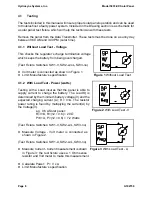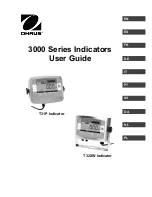
Model 5033-XX Solar Panel
HydroLynx Systems, Inc.
A102759
Page 7
The daily
insolation
refers to the
irradiance
integrated over time, the units of
insolation
are
Watts hours per square meter
(Whr/m²). A convenient way to estimate the solar panel
output is to divide the
insolation
by the
peak sunlight
giving the normalized
peak sun hours
per day
. The total electrical energy (Whr) produced by a solar panel in one day is equal
to the
peak sun hours
multiplied by the
peak power
output of the panel.
This means the power output of the solar panel depends upon the location of the gauge.
Across the continental United States the peak sun hours vary from one to five hours,
increasing as the latitude decreases.
3.2 Solar Panel
A solar panel contains photovoltaic (PV) cells that convert sunlight into direct current (dc)
electricity. The output depends on the number and configuration of PV cells, the intensity
of the sunlight, the temperature of the PV cells, and the load being powered.
There are two methods used to rate solar panel outputs: the Standard Test Condition
(STC) and the Normal Operating Condition (NOC). The STC simulates
peak sunlight
at
room temperature (1 kW/m² @ 25°C) which allows for comparison of solar panel power
ratings. The NOC tests the panel performance in actual field conditions which allow
designers a better estimate of true field performance.
3.3 Voltage Regulator
The voltage regulator optimizes charging performance from the solar panel while providing
overcharge protection for the system storage battery. A blocking diode is included in the
regulator to prevent minor discharge losses through the solar panel at night.
3.4 Power Requirements
Since Batteries are rated in Amp-Hours (Ahr) we calculate power requirements in this unit
rather than Watt-Hours (Whr). To determine Power Requirements we first calculate all the
current usages on a per day basis and then add these together for a daily total. We can
then size the battery and solar panel based on system specifications for days without
charging and hours of sun to fully recharge battery.
4.0 TESTING & MAINTENANCE
The Solar Panel requires yearly testing and maintenance under normal conditions.
Locations where debris (i.e. dirt, bird droppings and leaves) builds up on the panel require
more frequent maintenance. Whenever possible HydroLynx recommends reporting battery
voltage on a six hour interval. These report, spaced throughout the day, will give the
technician an indication of battery and solar panel fitness.
Summary of Contents for 5033-XX
Page 10: ......




























